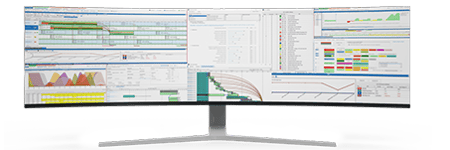Enhancing Strategic & Category Management Goals through Procurement Integration
In the industrial manufacturing sector, where complex supply chains and intricate procurement processes are the norms, aligning procurement with strategic goals is essential to maintain competitive advantage and operational efficiency. One of the most effective ways to achieve this alignment is by integrating procurement functions with business systems like ERP (Enterprise Resource Planning) platforms.
Combining tools like PlanetTogether APS (Advanced Planning & Scheduling) with SAP, Oracle, Microsoft, Kinaxis, or Aveva enables procurement teams to streamline operations and meet strategic and category management goals.
This integration not only improves visibility across the supply chain but also brings procurement into closer alignment with other business functions, creating a cohesive strategy that drives long-term success.

Procurement in Industrial Manufacturing
Procurement in industrial manufacturing is a complex, high-stakes function that involves more than merely purchasing materials. It encompasses sourcing, vendor management, risk assessment, and ensuring material availability to avoid production delays. Category management, a structured approach to sourcing where goods and services are organized by categories, plays a key role in aligning procurement with broader business strategies.
Integrating procurement with systems like PlanetTogether APS and ERP platforms enhances these functions by providing real-time visibility and facilitating data-driven decision-making. This alignment allows procurement managers to forecast demand, optimize inventory, and manage supplier relationships more effectively, directly contributing to both category management and overall strategic objectives.
![]()

Benefits of Integrating Procurement with ERP and APS Systems
When procurement integrates with an ERP system—whether it’s SAP, Oracle, Microsoft Dynamics, Kinaxis, or Aveva—it becomes an essential part of the company’s planning and operational processes. Combined with an APS system like PlanetTogether, this integration offers the following key benefits:
Enhanced Data Visibility: Data from procurement, production, and supply chain functions flows seamlessly, providing a holistic view of operations and enabling informed decision-making.
Increased Forecasting Accuracy: With access to real-time production data and demand forecasts, procurement teams can improve the accuracy of purchase orders and inventory levels.
Reduced Costs: Integration leads to better spend visibility, allowing procurement managers to optimize supplier selection and negotiate more favorable contracts.
Improved Supplier Relationships: Real-time collaboration with suppliers is facilitated by shared data, enabling proactive management of potential disruptions.
Strategic Category Management: Integrated systems provide insights into spending patterns and supplier performance, allowing procurement managers to develop more effective category strategies.

Key Strategies for Integrating Procurement with Business Systems
Successful integration of procurement with ERP and APS systems requires a well-thought-out approach. Here are some strategic steps to ensure the alignment of procurement with business goals:
Define Strategic Procurement Goals and KPIs
Before starting an integration project, it’s critical to define procurement’s strategic goals and key performance indicators (KPIs). For instance, goals may include reducing lead times, minimizing stockouts, improving supplier quality, or optimizing spend in each category. Clear goals allow for selecting the right metrics to monitor through the integrated system and for aligning these metrics with broader business objectives, such as cost reduction or sustainability initiatives.
PlanetTogether, in conjunction with your ERP, can track these KPIs in real time, giving procurement managers a dynamic view of their progress toward strategic goals.
Standardize Procurement Processes and Data
An integrated procurement system depends on standardized processes and data consistency. Establishing standardized procurement workflows, including vendor selection, purchase orders, and invoicing processes, is essential to seamless integration. This standardization is vital for maintaining accurate data flow and ensuring that procurement aligns with other business functions, especially production and inventory management.
Using PlanetTogether with an ERP platform like SAP or Microsoft Dynamics enhances data consistency across different departments, providing a single source of truth for procurement data.
Optimize Supplier Selection and Relationship Management
PlanetTogether’s APS system allows procurement teams to analyze supplier performance data, track lead times, and assess supplier quality. By integrating this information with ERP data, procurement managers can make data-driven supplier selection decisions that align with category management goals. For example, if a category goal is to reduce environmental impact, procurement teams can prioritize suppliers with sustainable practices, using insights from PlanetTogether’s analytics.
The combination of PlanetTogether and an ERP platform also enables better collaboration with suppliers by giving them access to relevant production schedules and forecasts, reducing stockouts and delivery delays.
Improve Demand Forecasting and Inventory Planning
Forecast accuracy is critical for procurement efficiency. PlanetTogether’s integration with ERP systems enhances demand forecasting by combining real-time production data with historical purchasing trends. This integration enables procurement teams to make proactive decisions, adjust order quantities, and optimize inventory levels to meet fluctuating demand without overstocking.
Moreover, PlanetTogether’s APS capabilities allow for scenario planning and simulations, giving procurement managers a tool to prepare for different demand and supply scenarios and make more informed purchasing decisions.
Utilize Analytics for Category Management
With integrated procurement systems, analytics become a powerful tool for category management. By aggregating data on spend, supplier performance, and order history, procurement managers can identify opportunities for cost savings, supplier consolidation, or alternative sourcing. The insights generated by PlanetTogether and ERP platforms can be applied to individual categories, leading to better control over spending and a more strategic approach to procurement.
For example, if a specific material category is a high-spend area, analytics can highlight potential savings through alternative suppliers, consolidated orders, or just-in-time inventory models.

Overcoming Challenges in Procurement Integration
While the benefits of integrating procurement with ERP and APS systems are substantial, challenges can arise. Here’s how to address some of the common obstacles:
Managing Data Compatibility and System Interoperability
Integrating different software systems often presents compatibility challenges. Ensuring that PlanetTogether can effectively communicate with an ERP system such as SAP, Oracle, or Microsoft Dynamics requires setting up data pipelines and ensuring consistent data formats. Working closely with IT teams and technology providers to map data fields, identify critical data flows, and create standardized protocols is essential for a smooth integration.
Ensuring User Adoption and Training
Procurement teams accustomed to traditional methods may be resistant to new technology. Providing comprehensive training and emphasizing the benefits of real-time data, supplier collaboration, and better forecasting can ease the transition. Involving end-users early in the process and gathering their feedback can improve user buy-in and make the system more effective.
Maintaining Data Security and Compliance
Data security is a top concern when integrating procurement with ERP and APS systems. Sensitive procurement data—like supplier contracts and pricing information—must be protected. ERP and APS providers like SAP, Oracle, Microsoft, Kinaxis, and Aveva typically offer robust security features, but it’s crucial to implement company-specific access controls, data encryption, and compliance monitoring to protect against data breaches.
Realizing the Benefits: The Future of Procurement in Industrial Manufacturing
By integrating procurement functions with ERP and APS systems, industrial manufacturing companies can transform procurement into a strategic asset. When PlanetTogether’s APS system aligns with ERP platforms like SAP, Oracle, or Kinaxis, procurement becomes more than just a cost center; it’s a driver of value, enabling proactive decision-making, improved supplier relationships, and better category management.
In this interconnected setup, procurement teams have the insights and tools to achieve strategic goals while supporting broader business functions, resulting in improved operational efficiency, cost savings, and a resilient supply chain. The seamless data flow and collaborative workflows created by these integrations offer industrial manufacturers a robust foundation to meet future market demands and competitive pressures.
For industrial manufacturing facilities aiming to elevate their procurement function, integrating procurement with PlanetTogether and ERP systems is a transformative strategy. This approach aligns procurement with business objectives, optimizes category management, and enables a proactive stance in supplier relationships and demand forecasting. By leveraging the capabilities of APS and ERP systems, procurement teams can drive strategic initiatives, streamline operations, and contribute meaningfully to the company’s long-term success.
Industrial manufacturing firms that prioritize procurement integration will find themselves well-prepared to tackle supply chain disruptions, market volatility, and the ever-growing complexity of the global marketplace. Embracing this digital transformation positions procurement as a competitive advantage, making it an invaluable asset in achieving both strategic and category management goals.
Are you ready to take your manufacturing operations to the next level? Contact us today to learn more about how PlanetTogether can help you achieve your goals and drive success in your industry.
Topics: Industrial Manufacturing, PlanetTogether Software, Integrating PlanetTogether, Increased Forecasting Accuracy, Strategic Category Management, Define Strategic Procurement Goals and KPIs, Standardize Procurement Processes and Data, Optimize Supplier Selection, Utilize Analytics for Category Management





















LEAVE A COMMENT